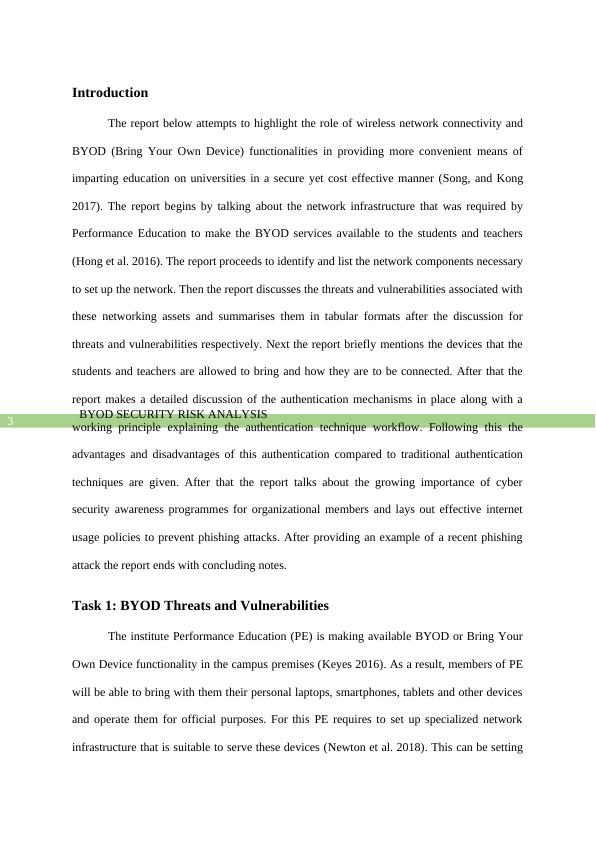BYOD Security Risk Analysis
Added on 2022-11-28
20 Pages4618 Words386 Views
Running head: BYOD SECURITY RISK ANALYSIS
BYOD Security Risk Analysis
Name of the Student
Name of the University
Author Note
BYOD Security Risk Analysis
Name of the Student
Name of the University
Author Note

BYOD SECURITY RISK ANALYSIS
1
Summary
According to several researches that have been conducted in recent years, wireless network
connectivity and functionalities like BYOD (Bring Your Own Device) is playing an
important role in providing more convenient means of imparting education on part of the
universities and that too in a cost efficient and secure manner. First the report is to talk about
the network infrastructure that was required by Performance Education to make the BYOD
services available to the students and teachers. The report is to proceed by identifying and list
the network components necessary to set up the network. Then the report is to discuss the
threats and vulnerabilities associated with these networking assets and is to summarise them
in tabular formats after the discussion for threats and vulnerabilities respectively. Next the
report must briefly mention the devices that the students and teachers are allowed to bring
and how they are to be connected. After that the report should make a detailed discussion of
the authentication mechanisms to be applied along with a working principle explaining the
authentication technique workflow. Following this the advantages and disadvantages of this
authentication compared to traditional authentication techniques should also be given. After
that the report is to talk about the growing importance of cyber security awareness
programmes for organizational members and must lay down effective internet usage policies
to prevent phishing attacks. After providing an example of a recent phishing attack the report
ends with concluding notes.
1
Summary
According to several researches that have been conducted in recent years, wireless network
connectivity and functionalities like BYOD (Bring Your Own Device) is playing an
important role in providing more convenient means of imparting education on part of the
universities and that too in a cost efficient and secure manner. First the report is to talk about
the network infrastructure that was required by Performance Education to make the BYOD
services available to the students and teachers. The report is to proceed by identifying and list
the network components necessary to set up the network. Then the report is to discuss the
threats and vulnerabilities associated with these networking assets and is to summarise them
in tabular formats after the discussion for threats and vulnerabilities respectively. Next the
report must briefly mention the devices that the students and teachers are allowed to bring
and how they are to be connected. After that the report should make a detailed discussion of
the authentication mechanisms to be applied along with a working principle explaining the
authentication technique workflow. Following this the advantages and disadvantages of this
authentication compared to traditional authentication techniques should also be given. After
that the report is to talk about the growing importance of cyber security awareness
programmes for organizational members and must lay down effective internet usage policies
to prevent phishing attacks. After providing an example of a recent phishing attack the report
ends with concluding notes.

BYOD SECURITY RISK ANALYSIS
2
Table of Contents
Introduction................................................................................................................................3
Task 1: BYOD Threats and Vulnerabilities...............................................................................3
Threats....................................................................................................................................4
Vulnerabilities........................................................................................................................5
BYOD Devices Availing the Wireless Network....................................................................7
Task 2: Working principle and mechanism of Certificate-Based Authentication.....................8
Advantages.............................................................................................................................9
Disadvantages........................................................................................................................9
Task 3: Instructions and Guidelines for Anti-phishing............................................................10
Effective Usage Policies......................................................................................................10
Conclusion................................................................................................................................13
References................................................................................................................................14
2
Table of Contents
Introduction................................................................................................................................3
Task 1: BYOD Threats and Vulnerabilities...............................................................................3
Threats....................................................................................................................................4
Vulnerabilities........................................................................................................................5
BYOD Devices Availing the Wireless Network....................................................................7
Task 2: Working principle and mechanism of Certificate-Based Authentication.....................8
Advantages.............................................................................................................................9
Disadvantages........................................................................................................................9
Task 3: Instructions and Guidelines for Anti-phishing............................................................10
Effective Usage Policies......................................................................................................10
Conclusion................................................................................................................................13
References................................................................................................................................14

BYOD SECURITY RISK ANALYSIS
3
Introduction
The report below attempts to highlight the role of wireless network connectivity and
BYOD (Bring Your Own Device) functionalities in providing more convenient means of
imparting education on universities in a secure yet cost effective manner (Song, and Kong
2017). The report begins by talking about the network infrastructure that was required by
Performance Education to make the BYOD services available to the students and teachers
(Hong et al. 2016). The report proceeds to identify and list the network components necessary
to set up the network. Then the report discusses the threats and vulnerabilities associated with
these networking assets and summarises them in tabular formats after the discussion for
threats and vulnerabilities respectively. Next the report briefly mentions the devices that the
students and teachers are allowed to bring and how they are to be connected. After that the
report makes a detailed discussion of the authentication mechanisms in place along with a
working principle explaining the authentication technique workflow. Following this the
advantages and disadvantages of this authentication compared to traditional authentication
techniques are given. After that the report talks about the growing importance of cyber
security awareness programmes for organizational members and lays out effective internet
usage policies to prevent phishing attacks. After providing an example of a recent phishing
attack the report ends with concluding notes.
Task 1: BYOD Threats and Vulnerabilities
The institute Performance Education (PE) is making available BYOD or Bring Your
Own Device functionality in the campus premises (Keyes 2016). As a result, members of PE
will be able to bring with them their personal laptops, smartphones, tablets and other devices
and operate them for official purposes. For this PE requires to set up specialized network
infrastructure that is suitable to serve these devices (Newton et al. 2018). This can be setting
3
Introduction
The report below attempts to highlight the role of wireless network connectivity and
BYOD (Bring Your Own Device) functionalities in providing more convenient means of
imparting education on universities in a secure yet cost effective manner (Song, and Kong
2017). The report begins by talking about the network infrastructure that was required by
Performance Education to make the BYOD services available to the students and teachers
(Hong et al. 2016). The report proceeds to identify and list the network components necessary
to set up the network. Then the report discusses the threats and vulnerabilities associated with
these networking assets and summarises them in tabular formats after the discussion for
threats and vulnerabilities respectively. Next the report briefly mentions the devices that the
students and teachers are allowed to bring and how they are to be connected. After that the
report makes a detailed discussion of the authentication mechanisms in place along with a
working principle explaining the authentication technique workflow. Following this the
advantages and disadvantages of this authentication compared to traditional authentication
techniques are given. After that the report talks about the growing importance of cyber
security awareness programmes for organizational members and lays out effective internet
usage policies to prevent phishing attacks. After providing an example of a recent phishing
attack the report ends with concluding notes.
Task 1: BYOD Threats and Vulnerabilities
The institute Performance Education (PE) is making available BYOD or Bring Your
Own Device functionality in the campus premises (Keyes 2016). As a result, members of PE
will be able to bring with them their personal laptops, smartphones, tablets and other devices
and operate them for official purposes. For this PE requires to set up specialized network
infrastructure that is suitable to serve these devices (Newton et al. 2018). This can be setting

End of preview
Want to access all the pages? Upload your documents or become a member.
Related Documents
Cyber Security: Risks and Solutions for South Cross Universitylg...
|12
|2052
|467
BYOD Policy Threats and Security Strategies for Cybersecuritylg...
|11
|2820
|426
Cyber Security: BYOD Risk Assessment, Certificate-based Authentication, and Anti-phishing Guidelinelg...
|9
|2240
|285
Risks and Vulnerabilities of BYOD Policy in Gigantic Corporationlg...
|12
|4187
|235
Security Consultation Report and Guidelinelg...
|13
|2447
|371
Solutions of Cybersecurity Assignmentlg...
|9
|2005
|320